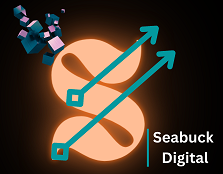I. Introduction
Welcome to the world of email marketing automation! In the current digital era, firms must stay on top of developments to be competitive. Do you know what the most important strategy global companies adopt is? Yes, that’s right. It is email marketing automation which can be a game-changer.

A. Definition of email marketing automation
The process of employing software to automate email marketing tasks, such as sending subscribers targeted and tailored emails based on their actions and behavior, is known as email marketing automation. With email marketing automation, businesses can save time and effort, while also delivering more relevant and timely messages to their subscribers.
According to Statista the global e-mail marketing market was estimated to be worth 7.5 billion US dollars in 2020, and according to the source, that amount would rise to 17.9 billion by 2027.
One of the study conducted by Ascend2 shows that 84% of the marketers that participated in the survey reported using marketing automation to accomplish their top priorities.
According to HubSpot the majority (72%) of the most prosperous businesses use marketing automation.
B. Importance of email marketing automation for businesses
So, why is email marketing automation so important for businesses?
- For starters, it allows businesses to build stronger relationships with their subscribers. By sending targeted and personalized messages, businesses can show their subscribers that they understand their needs and preferences. This, in turn, can lead to increased engagement, loyalty, and ultimately, sales.
- In addition, email marketing automation can help businesses improve their efficiency and productivity. Rather than manually sending emails, businesses can set up automated workflows that trigger emails based on specific criteria. This means that businesses can focus on other important tasks, while still delivering timely and relevant messages to their subscribers.
- Ultimately, email marketing automation is a powerful instrument that may assist companies in remaining competitive in the quick-paced digital environment of today.
We’ll examine the essential elements of an email marketing automation workflow in more detail in the following section.
II. Key Components of Email Marketing Automation Workflow
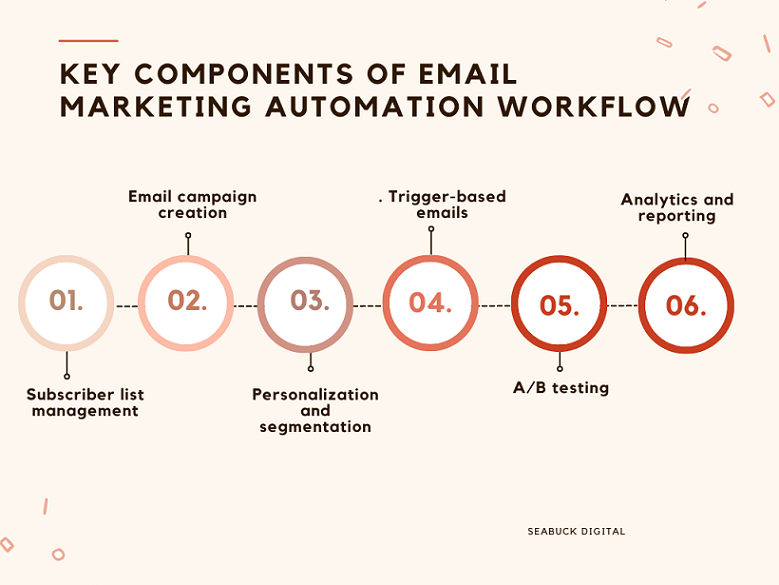
Now that we’ve covered the basics of email marketing automation, let’s dive into the key components of an email marketing automation workflow.
A. Subscriber list management
A crucial component of email marketing automation is subscriber list management. This involves collecting and organizing your subscribers’ information, such as their names, email addresses, and preferences. With a well-maintained subscriber list, businesses can deliver more targeted and personalized messages to their subscribers. It’s also important to regularly clean your subscriber list by removing inactive or bounced email addresses, as this can help improve your email deliverability and engagement rates.
B. Email campaign creation
Next up is email campaign creation. With email marketing automation, businesses can create and schedule automated email campaigns. These campaigns are triggered by specific actions or events, such as a subscriber signing up for a newsletter or making a purchase. The key here is to create engaging and relevant content that resonates with your subscribers, whether it’s a promotional offer, a helpful resource, or a simple welcome message.
C. Personalization and segmentation
Personalization and segmentation are also key components of an email marketing automation workflow. You may send more focused and personalized messages that are catered to each subscriber’s unique interests and needs by segmenting your subscriber list based on variables like demographics, purchase history, and engagement levels. Personalization can also include elements such as using a subscriber’s name in the email subject line or body, or including personalized product recommendations based on their previous purchases.
D. Trigger-based emails
Trigger-based emails are another important component of an email marketing automation workflow. These are emails that are triggered by a specific action or event, such as a subscriber abandoning their shopping cart or reaching a certain engagement threshold. These types of emails are highly targeted and can lead to increased engagement and conversions.
E. A/B testing
A/B testing is also a crucial component of email marketing automation. By testing different elements of your emails, such as subject lines, calls-to-action, and content, businesses can gain valuable insights into what resonates best with their subscribers. These valuable insights will guide businesses to improve their overall email performance.
F. Analytics and reporting
Finally, analytics and reporting are essential for measuring the success of your email marketing automation efforts. Businesses may better understand what is and isn’t working by tracking data like open rates, click-through rates, and conversions. This deeper understanding will allow businesses to make data-driven decisions to improve their email campaigns over time.
In summary, the key components of an email marketing automation workflow include subscriber list management, email campaign creation, personalization and segmentation, trigger-based emails, A/B testing, and analytics and reporting. There are various email marketing tools that encompasses these above components. By mastering these components, businesses can create effective email campaigns that deliver real results.
III. Benefits of Automation in Email Marketing
Now that we’ve covered the key components of an email marketing automation workflow, let’s talk about the benefits that automation can bring to businesses.
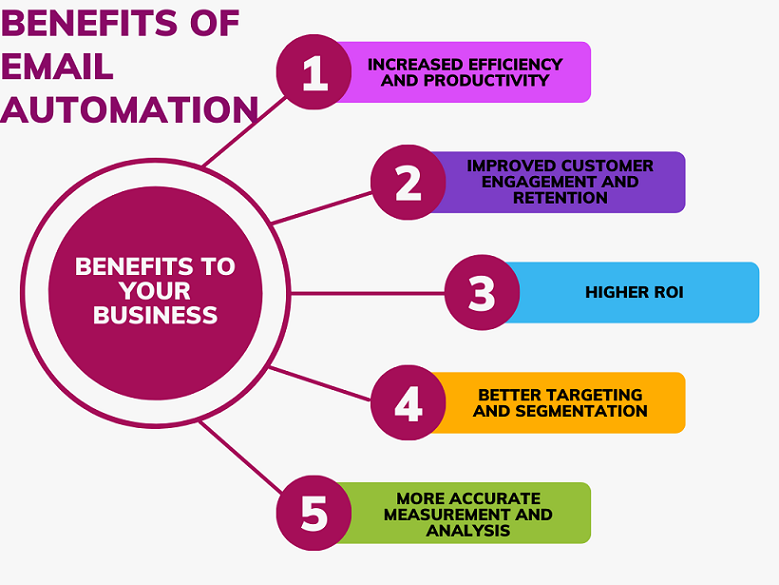
A. Increased efficiency and productivity
First and foremost, email marketing automation can greatly increase efficiency and productivity. Businesses can save time and focus on other important aspects of their operations by automating repetitive tasks such as list management, campaign creation, and reporting. This also means that businesses can send timely and relevant messages to their subscribers without requiring manual intervention.
A study by Pendalix shows that according to 49% of businesses, the primary advantages of marketing automation are time savings on monotonous work and the facilitation of personalized client communications.
B. Improved customer engagement and retention
Another key benefit of email marketing automation is improved customer engagement and retention. With more targeted and personalized messages, businesses can better connect with their subscribers and build stronger relationships over time. This can lead to increased customer loyalty, repeat purchases, and positive word-of-mouth.
A study by Pendalix shows the primary motivation, according to 34% of marketers, is to increase consumer engagement and experiences.
C. Higher ROI
Email marketing automation can also result in higher ROI for businesses. By delivering more relevant messages to subscribers and automating campaigns, businesses can see an increase in conversions and revenue. Businesses can track their performance and optimize their campaigns for even better results by using analytics and reporting tools.
A study by Pendalix shows that an additional 45% of marketers responded that increased efficiency and ROI were the main benefits of email automation.
D. Better targeting and segmentation
Better targeting and segmentation are also key benefits of email marketing automation. By segmenting their subscriber list and delivering targeted messages to specific groups, businesses can improve their overall engagement rates and achieve better results. This can lead to a more personalized customer experience and better customer satisfaction.
E. More accurate measurement and analysis
Finally, email marketing automation provides businesses with more accurate measurement and analysis. Businesses can gain valuable insights into their subscriber behavior and adjust their campaigns accordingly by tracking metrics such as open rates, click-through rates, and conversions, . This can help businesses to continuously improve their campaigns and achieve even better results over time.
In conclusion, email marketing automation provides numerous benefits to businesses, including increased efficiency and productivity, improved customer engagement and retention, higher ROI, better targeting and segmentation, and more accurate measurement and analysis. By leveraging the power of automation, businesses can create effective email campaigns that deliver real results and help them to achieve their marketing goals.
IV. Examples of Email Marketing Automation Workflows
After discussing the advantages of email marketing automation, let’s examine some specific instances of automation workflows that companies may use to make the most of their email marketing initiatives.
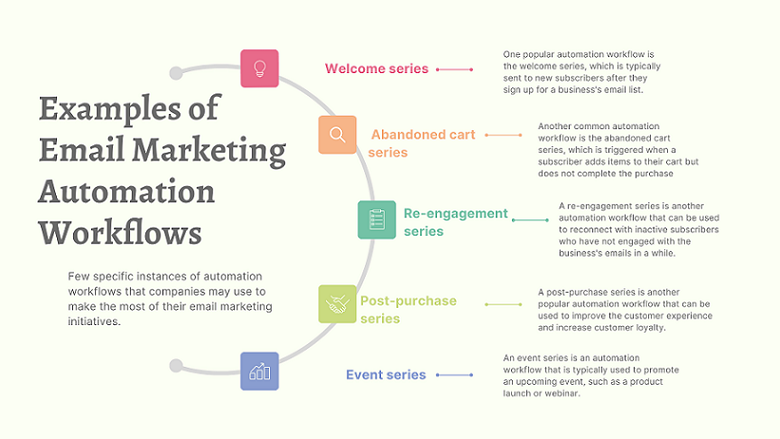
A. Welcome series
One popular automation workflow is the welcome series, which is typically sent to new subscribers after they sign up for a business’s email list. The welcome series can include a series of emails that introduce the business and its products or services, as well as provide subscribers with valuable information and offers. This can help to build trust and establish a connection with new subscribers right from the start.
B. Abandoned cart series
Another common automation workflow is the abandoned cart series, which is triggered when a subscriber adds items to their cart but does not complete the purchase. The series typically includes a series of emails that remind the subscriber about the items in their cart and encourage them to complete the purchase. This can help to recover lost sales and increase overall revenue for the business.
C. Re-engagement series
A re-engagement series is another automation workflow that can be used to reconnect with inactive subscribers who have not engaged with the business’s emails in a while. The series can include a series of emails that remind subscribers about the benefits of being on the email list and encourage them to re-engage with the business. This can help to reduce list churn and keep subscribers engaged over the long-term.
D. Post-purchase series
A post-purchase series is another popular automation workflow that can be used to improve the customer experience and increase customer loyalty. The series typically includes a series of emails that follow up with customers after they make a purchase. These types of emails provide them with valuable information and offer to encourage them to make future purchases. This can help to build stronger relationships with customers and improve customer retention rates.
E. Event series
Finally, an event series is an automation workflow that is typically used to promote an upcoming event, such as a product launch or webinar. The series can include a series of emails that provide subscribers with information about the event. These types of emails include the date, time, and location, as well as valuable information and offer to encourage them to attend. This can help to increase attendance and engagement for the event, as well as generate buzz and interest for the business.
In conclusion, there are numerous examples of email marketing automation workflows that businesses can implement to maximize their email marketing efforts. From welcome series and abandoned cart series to re-engagement series, post-purchase series, and event series, there are many ways that businesses can use automation to create effective email campaigns that deliver real results and help them to achieve their marketing goals.
V. Best Practices for Automated Email Marketing Workflow
Now that we’ve explored the key components and benefits of email marketing automation workflows, let’s discuss some best practices for creating effective campaigns.
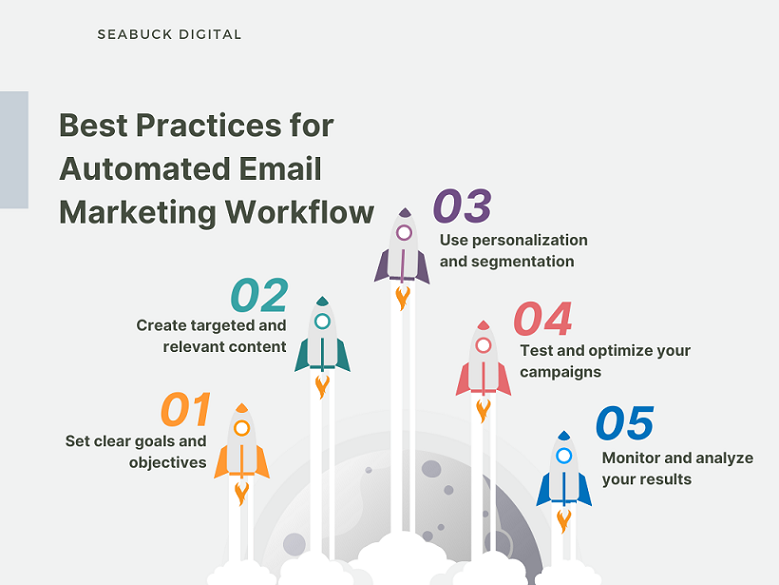
A. Set clear goals and objectives
It’s important to set clear goals and objectives for what you want to achieve before you start creating your automation workflow, . Do you want to increase sales, drive website traffic, or improve customer engagement? After you are certain of your objectives, you can create your automated workflow to bring about those particular outcomes.
B. Create targeted and relevant content
It’s important to create targeted and relevant content that resonates with your audience to engage your subscribers and drive conversions. This means using language and messaging that speaks directly to their needs and interests, and providing valuable information and offers that are tailored to their preferences.
C. Use personalization and segmentation
Personalization and segmentation are powerful tools that can help you create more relevant and effective email campaigns. You can tailor your messaging and offers to specific groups of subscribers by segmenting your audience based on factors like demographics, purchase history, and behavior. This strategy will increase the likelihood of subscribers engaging with your content and take action.
D. Test and optimize your campaigns
Testing and optimization are key to improving the effectiveness of your automation workflow over time. You may determine what appeals to your audience the most by doing A/B testing on various campaign components, like as subject lines, call-to-action buttons, and content. Then, you can adjust your strategy appropriately.
E. Monitor and analyze your results
Finally, it’s critical to consistently track and evaluate the outcomes of your automation workflow in order to assess its efficacy and pinpoint opportunities for development. Track important metrics with analytics tools, like as open rates, click-through rates, and conversion rates, and use the information to improve your strategy and optimize your campaigns for better outcomes.
You may design automated email marketing campaigns that produce tangible results and assist you in reaching your marketing objectives by adhering to these best practices. Automation is a powerful tool for meeting your marketing goals. The process will propel your business growth, whether you’re aiming to raise sales, enhance client engagement, or increase website traffic.
VI. Conclusion
As a result, email marketing automation is an effective tool for companies aiming to engage their audience, boost sales, and promote company growth. By automating key components of the email marketing process, such as subscriber list management, email campaign creation, and analytics and reporting, businesses can improve efficiency, productivity, and ROI.
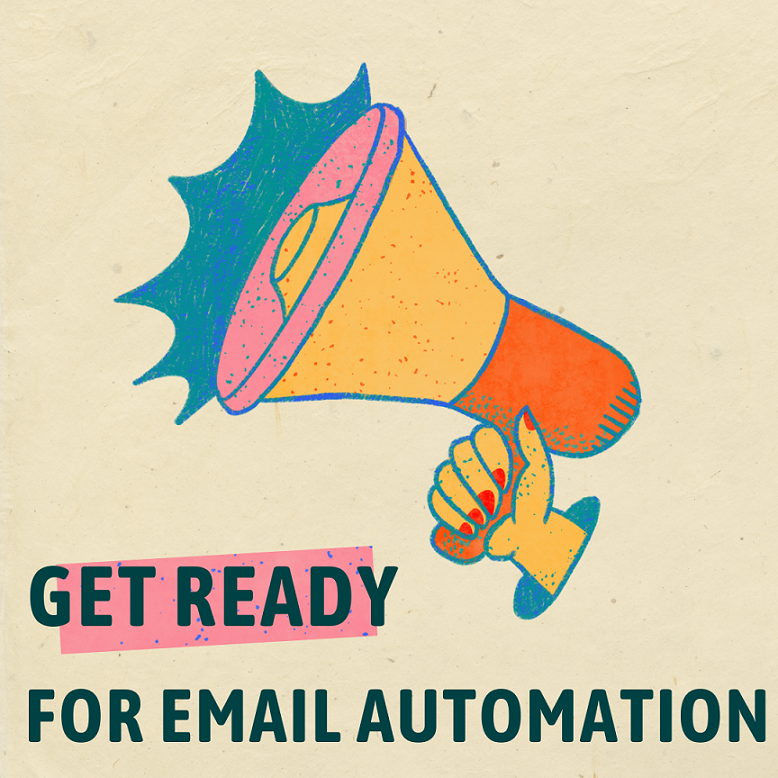
A. Recap of the benefits and key components of email marketing automation
The key components of email marketing automation workflow include subscriber list management, email campaign creation, personalization and segmentation, trigger-based emails, A/B testing, and analytics and reporting. You can create targeted and relevant campaigns that resonate with your audience and drive conversions by incorporating these elements into your automation workflow.
B. Final thoughts on the importance of implementing email marketing automation in your business
According to Statista, global marketing experts claim that, after content marketing, marketing automation is the most successful digital marketing strategy.
Increased effectiveness and productivity, better client engagement and retention, higher ROI, better targeting and segmentation, and more precise measurement and analysis are all advantages of automation in email marketing. Businesses may streamline their email marketing initiatives and get greater results with less time and effort by utilizing the power of automation.
In today’s fast-paced business environment, email marketing automation has become a must-have for businesses looking to stay competitive and drive growth. By implementing best practices such as setting clear goals and objectives, creating targeted and relevant content, using personalization and segmentation, testing and optimizing campaigns, and monitoring and analyzing results, businesses can create automation workflows that deliver real results and drive business success.
C. It’s time for you to explore the power of email marketing automation
It is now time, if you haven’t already, to begin investigating the potential of email marketing automation for your company. You may advance your email marketing efforts and have actual success in the current digital environment by using the appropriate plan and technique.
